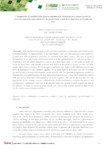Por favor, use este identificador para citar o enlazar este ítem:
http://www.alice.cnptia.embrapa.br/alice/handle/doc/1072023Registro completo de metadatos
| Campo DC | Valor | Lengua/Idioma |
|---|---|---|
| dc.contributor.author | OLIVEIRA, M. V. N. d' | pt_BR |
| dc.contributor.author | OLIVEIRA, L. C. de | pt_BR |
| dc.date.accessioned | 2017-07-05T11:11:11Z | pt_BR |
| dc.date.available | 2017-07-05T11:11:11Z | pt_BR |
| dc.date.created | 2017-07-05 | pt_BR |
| dc.date.issued | 2017 | pt_BR |
| dc.identifier.citation | In: SIMPÓSIO BRASILEIRO DE SENSORIAMENTO REMOTO, 18., 2017, Santos. Anais... Santos: Inpe, 2017. | pt_BR |
| dc.identifier.uri | http://www.alice.cnptia.embrapa.br/alice/handle/doc/1072023 | pt_BR |
| dc.description | Lidar data has been largely used to produce estimative on biomass and timber stocks in tropical forests. A major problem is the lidar flights costs, and the exhaustive and expensive ground plot data acquisition necessary to calibrate lidar data metrics. The use of ground information from previously established plots and the generalization of existent models to structurally similar forests should be a way to minimize these costs. In this work we study six forest in Acre state with similar structure and different disturbance history covered by lidar flights and forest inventories. We investigate whether the use of plots with different sizes violate the null hypothesis of the variance equality of the lidar metrics and tested the use of a lidar general model to estimate the biomass on the studied sites. We generated regression models to estimate above ground biomass for each area and compared them to a general model elaborated with the ground and lidar information of all areas together. The results showed that the null hypotheses of the variance was not violated to the variable selected to compose the models and no significant differences were found among the local and general models suggesting that in the absence of forest inventories, when forest were structurally similar, a general lidar model can be used to assess biomass stocks. | pt_BR |
| dc.language.iso | por | pt_BR |
| dc.rights | openAccess | pt_BR |
| dc.subject | Geotécnica | pt_BR |
| dc.subject | Terra Indígena Kaxinawá de Nova Olinda (AC) | pt_BR |
| dc.subject | Feijó (AC) | pt_BR |
| dc.subject | Floresta Estadual do Antimary (AC) | pt_BR |
| dc.subject | Bujari (AC) | pt_BR |
| dc.subject | Sena Madureira (AC) | pt_BR |
| dc.subject | Projeto de Assentamento Dirigido Humaita (AC) | pt_BR |
| dc.subject | Porto Acre (AC) | pt_BR |
| dc.subject | Fazenda Bonal | pt_BR |
| dc.subject | Senador Guiomard (AC) | pt_BR |
| dc.subject | Embrapa Acre | pt_BR |
| dc.subject | Rio Branco (AC) | pt_BR |
| dc.subject | Acre | pt_BR |
| dc.subject | Amazônia Ocidental | pt_BR |
| dc.subject | Western Amazon | pt_BR |
| dc.subject | Amazonia Occidental | pt_BR |
| dc.subject | Análisis de regresión | pt_BR |
| dc.subject | Análisis estadístico | pt_BR |
| dc.subject | Biomasa aérea | pt_BR |
| dc.subject | Teledetección | pt_BR |
| dc.title | Comparação de modelos lidar para a estimativa de biomassa seca acima do solo de florestas com diferentes históricos de perturbação natural ou antrópica no Estado do Acre. | pt_BR |
| dc.type | Artigo em anais e proceedings | pt_BR |
| dc.date.updated | 2017-11-08T11:11:11Z | pt_BR |
| dc.subject.thesagro | Biomassa | pt_BR |
| dc.subject.thesagro | Parte aérea | pt_BR |
| dc.subject.thesagro | Estimativa | pt_BR |
| dc.subject.thesagro | Sensoriamento remoto | pt_BR |
| dc.subject.thesagro | Raio laser | pt_BR |
| dc.subject.thesagro | Análise estatística | pt_BR |
| dc.subject.thesagro | Regressão linear | pt_BR |
| dc.subject.nalthesaurus | Aboveground biomass | pt_BR |
| dc.subject.nalthesaurus | Remote sensing | pt_BR |
| dc.subject.nalthesaurus | Lidar | pt_BR |
| dc.subject.nalthesaurus | Statistical analysis | pt_BR |
| dc.subject.nalthesaurus | Regression analysis | pt_BR |
| dc.subject.nalthesaurus | Lásers | pt_BR |
| dc.format.extent2 | 8 p. | pt_BR |
| riaa.ainfo.id | 1072023 | pt_BR |
| riaa.ainfo.lastupdate | 2017-11-08 -02:00:00 | pt_BR |
| dc.contributor.institution | MARCUS VINICIO NEVES D OLIVEIRA, CPAF-Acre; LUIS CLAUDIO DE OLIVEIRA, CPAF-Acre. | pt_BR |
| Aparece en las colecciones: | Artigo em anais de congresso (CPAF-AC)  | |
Ficheros en este ítem:
| Fichero | Descripción | Tamaño | Formato | |
|---|---|---|---|---|
| 26343.pdf | 481,69 kB | Adobe PDF |  Visualizar/Abrir |









